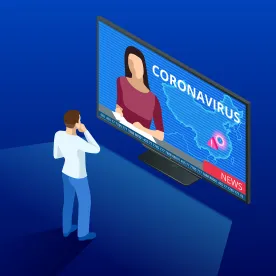Since releasing our Advisory on January 30, 2020, there have been significant developments in connection with the 2019 Novel Coronavirus (“COVID-19” or “Coronavirus”).[1] For example, on February 25, 2020, the U.S. Centers for Disease Control and Prevention (“CDC”) warned Americans that the Coronavirus was likely to hit the United States and that they should begin making preparations.
Below, we provide some updates since our January 30th Advisory, as well as best practices in responding to these issues.
Government Response
On January 31, 2020, the U.S. Department of Health and Human Services (“HHS”) declared a public health emergency relating to COVID-19. Because of this declaration, HHS:
-
issued a mandatory 14-day quarantine for any U.S. citizen returning from China’s Hubei province (the Department of Defense authorized funds for temporary housing for those impacted by the quarantine);
-
stated that U.S. citizens who have been anywhere else in mainland China (outside Hubei province) must, within 14 days, undergo a proactive entry health screening at airports or other ports of entry; and
-
is recommending that any U.S. citizens who have been in China engage in up to 14 days of “monitored self-quarantine to ensure they have not contracted the virus and do not pose a public health risk.”
Non-U.S. citizens traveling from China, directly or indirectly, will not be allowed to enter the United States. On February 25, 2020, the CDC stated that the threat in the United States is still low, yet it is likely that COVID-19 is going to have a greater impact here.
On February 26, 2020, Vice President Mike Pence announced Ambassador Debbie Birx as the White House Coronavirus Response Coordinator. She will report directly to VP Pence and join the task force led by HHS Secretary Alex Azar to combat the Coronavirus.
There have been 15[2] confirmed cases in the United States. On February 27, 2020, an individual in California who had not traveled to China or interacted with anyone known to be infected, tested positive for the Coronavirus. Additionally, as of that date, more than 2,800 individuals worldwide have died from COVID-19. Although most deaths and COVID-19 cases are still in mainland China, there has been an increase in the spread of COVID-19 outside of China.
The CDC has issued a Level 3 travel warning for China and South Korea, and is recommending that individuals avoid all nonessential travel to these countries. Further, the CDC has issued an Alert Level 2 – Practice Enhanced Precautions for Italy, Iran, and Japan with respect to COVID-19. There is also a Watch Level 1 – Practice Usual Precautions for travel to Hong Kong. As of this time, however, cases have been identified on all continents except Antarctica.
The CDC’s risk assessment states that the “potential public health threat posed by COVID-19 is high, both globally and to the United States”; however, individual risk depends upon exposure. For the general public in the United States, “the immediate health risk from COVID-19 is considered low.” The World Health Organization (“WHO”) has raised the risk level to “very high.” The CDC recognizes that some people may have an increased risk of infection, including health care workers or others who are in close contact with someone who has COVID-19.
States and municipalities have also issued guidance addressing COVID-19. The City of San Francisco and Orange County, California, issued states of emergency, even though no cases have been confirmed in either location. Nassau County, New York, is monitoring a group of more than 80 individuals who recently visited mainland China, all of whom are now in quarantine.
CDC Interim Guidance for Businesses and Employers
The CDC has published an Interim Guidance for Businesses and Employers (“Interim Guidance”), which cautions employers to use the guidance to determine risk of the Coronavirus, and to not use race or country of origin to make a determination of risk. The Interim Guidance advises employers to:
-
encourage sick employees to stay home (even without a doctor’s note);[3]
-
separate sick employees, and send employees home if they appear to have acute respiratory illness symptoms;
-
encourage healthy practices, including emphasizing that employees stay home when sick and urging employees to clean their hands often with alcohol-based hand sanitizer that contains at least 60 percent alcohol or wash their hands with soap and water for at least 20 seconds;
-
perform routine environmental cleaning, and provide disposable wipes so that employees can wipe down commonly used surfaces; and
-
advise employees to review CDC traveler’s health notices before traveling and to check themselves for symptoms of acute respiratory illness upon return.
The Interim Guidance further states that employees should notify their employer if the employee’s family member is sick at home with COVID-19. Additionally, per the Interim Guidance, if an employee is confirmed to have the Coronavirus, “employers should inform fellow employees of the possible exposure to COVID-19,” while maintaining the confidentiality of health information pursuant to the Americans with Disabilities Act. Depending on the nature of the workforce, employers will need to balance privacy interests of the affected individual(s) with the need to adequately inform their workforce. Further, any employees who have had close contact with a person with confirmed COVID-19 infection should follow the Interim Guidance, including remaining away from work until the potential 14-day incubation period has expired.
The CDC has also published multiple guidance documents for health care professionals.
Creating an Infectious Disease Outbreak Plan
The Interim Guidance encourages employers to plan for a possible Coronavirus outbreak in the United States and advises employers to ensure that their plan is flexible and communicated to employees. The CDC’s guidance on creating an infectious disease outbreak plan includes:
-
identifying possible work-related exposure and health risks to employees (including reviewing materials from the Occupational Safety and Health Administration (“OSHA”));
-
coordinating existing policies (including leaves, accommodations, and flexible working arrangements);
-
establishing flexible working arrangements, including remote work and staggered shifts “to increase the physical distance among employees and between employees and others if state and local health authorities recommend the use of social distancing strategies,” and, if allowing remote work, considering any IT needs to support a remote workforce while maintaining data security, especially for Health Insurance Portability and Accountability Act (“HIPAA”)-covered entities;
-
identifying essential business functions, essential jobs or roles, and critical elements within a company’s supply chains required to maintain business operations and planning for interruptions;
-
setting up triggers and procedures for activating and terminating the company’s infectious disease outbreak response plan, altering business operations, and informing employees;
-
planning for school closures;[4]
-
monitoring travel guidance and attendance at large work-related meetings or events; and
-
coordinating with state and local health departments.
Considerations for Employers
Testing
The CDC’s test to determine whether an individual has contracted Coronavirus is, at this time, only available at a laboratory that the CDC has designated as qualified. It is unclear whether testing will be made available to most health care practitioners; the CDC has indicated only that it will soon “share these tests with domestic and international partners.” New York has asked the CDC for authorization to test in-state, rather than requiring samples to be sent to the CDC’s headquarters in Atlanta, Georgia. New York is also creating its own test for COVID-19.
It is not clear whether employees who are concerned about exposure to COVID-19 may seek a test for Coronavirus from their own health care provider. Thus, if any employee raises a concern about exposure to Coronavirus and potential symptoms, employers should encourage the employee to seek emergency assistance and contact their state/local health department(s).
Travel and Quarantine (Mandatory or Self-Imposed)
As noted above, the CDC has advised avoiding all nonessential travel to China and South Korea, and has warned against travel to Japan, Italy, and Iran. The United States has imposed mandatory quarantines for over 300 individuals at military bases in California, Colorado, Nebraska, and Texas. Based on HHS guidance, many employers are also requiring a 14-day self-quarantine—restricting employees from coming into the office—for individuals who have returned from certain countries with a higher risk of COVID-19.
During a self-imposed quarantine, employers may permit employees to work remotely, if the employees’ job duties permit. For employees who cannot work from home, employers may wish to consider—based on their vacation, sick, and/or time off policies and applicable law—whether to apply such paid time or to provide pay to quarantined employees separate and apart from the employee’s accrued time off. Compliance with applicable collective bargaining agreements should also be examined in the case of union-represented workers.
As a precautionary measure, employers should consider whether travel to large conferences or events is essential at this time. Indeed, employers may wish to make attendance optional, especially if it is likely that attendees will have traveled from areas impacted by COVID‑19. In connection with making attendance optional, employers should make clear that employees need not provide any explanation for their decision not to attend. This way, employees will not be required to reveal the reason(s) behind their decision, which may be related to protected characteristics, such as the employee’s health (e.g., compromised immune system, pregnancy, etc.) or caregiver status (e.g., elderly relatives in the home).
Packages
The WHO has issued guidance confirming that it is safe to receive packages from China and other places where COVID-19 has been identified.
Places of Public Accommodation
If an employer’s place of business is open to the public, and thus some or all of its workplace is considered a place of public accommodation, the employer should be cautious when refusing service to certain groups of individuals. Such employers should ensure that customers are not refused service or singled out based on their ethnicity or national origin, such as refusing service to any individual who may be of Chinese or Southeast Asian descent.
Communications with Employees
Many employers are sending communications to employees with general information about the Coronavirus, including the symptoms. Additionally, some employers have advised their employees that if they are concerned that they may have been exposed to the Coronavirus, (e.g., if they have recently traveled to certain countries with a higher risk of COVID-19), they should not come into work and should contact the local health department and/or the CDC. As noted above, the U.S. government is recommending that anyone returning from China engage in a 14-day self-imposed quarantine.
Visa Renewals
The Presidential Proclamation of February 2, 2020, suspending entry of immigrants and non-immigrants who were physically in China, can impact U.S. employers, as can an employer’s reluctance to permit employees to go abroad for visa renewals and extensions of work authorizations. Employers should consider the possible problematic effects of the lack of work authorizations. If travel to an employee’s country of origin is not feasible, employers may suggest that employees seek extensions of non-immigrant status with U.S. Citizenship and Immigrations Services. When a timely application is made, this can secure continued work authorizations.
What Employers Should Do Now
-
Appoint a single individual or department as the point of contact within your organization for questions about Coronavirus and to ensure a coordinated and consistent response to all inquiries.
-
Provide updated information to employees about the symptoms of COVID-19 and affected areas.
-
Educate supervisors on the company’s planned preventative steps.
-
Review business-related travel itineraries for employees, and consider whether any travel to high-risk areas is necessary.
-
Determine if additional obligations are imposed on your workplace by HIPAA’s Privacy Rule.
-
Assure that your policies and practices meet pertinent OSHA (and CDC) standards, especially for health care employees when blood-borne pathogens may be present.
-
If employees are represented by a union, consider whether there are any issues that need to be addressed with the employees’ bargaining representative and whether there are any provisions in the company’s collective bargaining agreements that may be affected.
-
Promptly address any leave or accommodation requests from employees, and remind employees of leave and call-out policies.
-
If any employees will not be allowed in the office due to exposure or symptoms, determine if telework is viable. If an employee will not be allowed in the office or to telework, communicate whether he or she will be paid or, rather, whether he or she can use sick, vacation, or any other type of paid leave.
-
Consider creating an infectious disease outbreak plan.
-
Work with employees facing travel restrictions and visa renewal issues.
* * * *
ENDNOTES
[1] On February 11, 2020, the World Health Organization proposed “COVID-19” as the label for the coronavirus disease 2019.
[2] Also, 42 U.S. citizens traveling on the Diamond Princess Cruise Ship were confirmed to have contracted the Coronavirus.
[3] Many state and local sick leave laws may allow people to use sick leave when there is a public health emergency.
[4] Employers should be mindful that many sick leave laws allow employees to use sick time when a child’s school or place of care is closed due to a public health emergency. Additionally, many such laws protect the use of such leave to care for employees’ family members.








 />i
/>i
